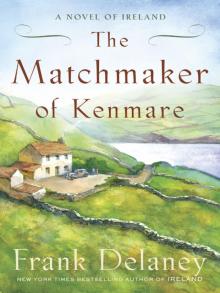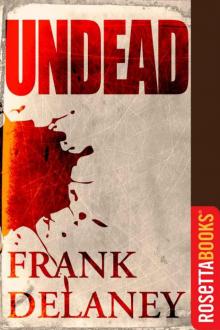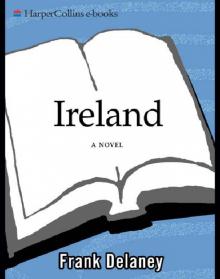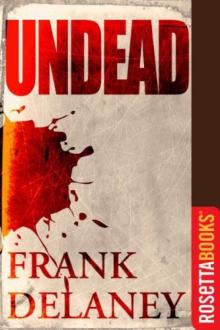- Home
- Frank Delaney
Undead (Kindle Single) Page 2
Undead (Kindle Single) Read online
Page 2
Sheridan le Fanu (pronounced leff-anew) became at the time the best-known writer of ghost stories in the English language. They still deliver a kick. Read Mr. Justice Harbottle, about a judge who sees ghosts: “They did not seem to glide, but walked as living men do, but without any sound, and he felt a vibration of the floor as they crossed it.”
Or his best story, Strange Event in the Life of Schalken the Painter, who is visited by somebody from the past: “There was an air of gravity and importance about the garb of this person, and something indescribably odd, I might say awful, in the perfect, stone-like movelessness of the figure.”
I’d call Sheridan Le Fanu the man who spread the gospel of horror fantasy. He so understood the genre: his stories have a calm modus operandi; the ghosts are plausible before they become terrifying; they haunt ordinary and believable settings.
Some Irish folklore influences creep in (people vanish or go crazy around ruined castles), but Le Fanu drew on another feverish source – a frequent and massive intake of opium. A connection between horror fantasy and drug addiction? No surprises there. (To offset his dependence, by the way, this reclusive, rather sad man drank gallons of green tea: there’s even a brand named after him.)
One of Le Fanu’s most renowned tales, Carmilla, is set – where else? - in eastern Europe, and it pushed the vampire thing forward another few paces, because his bloodsucker was a lady: aristocratic, captivating, aglow.
“Her complexion was rich and brilliant; her features were small and beautifully formed; her eyes large, dark, and lustrous; her hair was quite wonderful, I never saw hair so magnificently thick and long when it was down about her shoulders; I have often placed my hands under it, and laughed with wonder at its weight.”
But – that was no lady, that was my vampire. “With gloating eyes she drew me to her, and her hot lips traveled along my cheek in kisses; and she would whisper, almost in sobs, ’You shall be mine, and you and I are one forever…”
Carmilla appeared in 1872, when Bram Stoker was 25. In effect, his stage was now set. Real and sacrificial blood; medically endorsed vampires; bandits, peasants, an English lord, a beautiful temptress – Stoker had a candy store facing him. And then, while he was deep in the writing of Dracula, on a visit to the United States, he found this newspaper report from the New York World, dated Sunday, February 2, 1896 – the clipping, so modern in language, appears in his extensive research notes.
VAMPIRES IN NEW ENGLAND: DEAD BODIES DUG UP AND THEIR HEARTS BURNED TO PREVENT DISEASE.
“Recent ethnological research has disclosed something very extraordinary in Rhode Island. It appears that the ancient vampire superstition still survives in that state, and within the last few years many people have been digging up the dead bodies of relatives for the purpose of burning their hearts.
“Near Newport scores of such exhumations have been made, the purpose being to prevent the dead from preying upon the living. The belief entertained is the person who is dying of consumption is likely to rise from the grave at night and suck the blood of surviving members of his or her family, thus dooming them to a similar fate.”
IV: The Man who Wrote Dracula
Bram – Abraham – Stoker was born in Dublin in November 1847, the third of seven children. Ireland at that time had three general strata in the population. The native, mostly destitute Catholics formed about eighty-five percent; in the remaining fifteen percent, the Anglo-Irish upper class oversaw a country administered for them by their own Protestant middle class, Stoker’s people.
The name “Stoker,” probably Dutch in origin, comes down the same utilitarian road as Carpenter or Smith – some ancestor of Bram’s had once fed and tended a furnace. His father, also Abraham, was a minor public servant, and his mother, Charlotte Thornley, a well-known do-gooder and anti-poverty campaigner. They lived in affluent suburbs of Dublin, and educated their children diligently; three of the sons became doctors.
But not Bram. He didn’t go to the same schools. The most important fact about Bram Stoker's childhood is often singled out as having caused Dracula - he suffered a long and undefined, undiagnosed childhood illness. “In my babyhood I used, I understand, to be often at the point of death. Certainly till I was about seven years old I never knew what it was to stand upright. I was naturally thoughtful and the leisure of long illness gave opportunity for many thoughts which were fruitful according to their kind in later years.”
He emerged fighting fit – “un-dead,” if you like, the beneficiary of what seemed like a miraculous cure. Here comes the first temptation to link the life to the work. The French novelist, Mauriac, believed that the door slams shut on a writer around the age of 12 - meaning that all your raw material is in place by then. In Stoker’s case, he survived the childhood illness – and vampires don’t die. I’m further tempted to throw in the fact that the Irish doctors still used bloodletting in the nineteenth century. Especially for mysterious ailments.
After his recovery, Bram’s mother sent him to a small private school. From there he drifted towards college. There was energy in him, but more eagerness than genius; in the entrance contest for Trinity College, Dublin, Bram came fortieth in the fifty-one applicants who sat the examination.
Yet they noticed him at Trinity; he looked like the heroes of his romantic novels and short stories. They’re always men of fine stature, broad-shouldered, deep-chested, lean-flanked, athletic, never shorter than six feet two, inspiring in the gymnasium, heroic on the rugby field, handsomely poised, firm of neck and strong of head, sentimental over babies, and kind to old ladies. A Scottish hotel-keeper near the vast ruined castle at Slains remembered Mr. Stoker as a big, friendly, red-haired, red-bearded Irishman who liked walking and talking.
Talking, certainly. They claim in Trinity that the Philosophical Society is the oldest debating group in the world. Stoker became an officer of “The Phil”, organized and chaired debates, and delivered papers. One of them was formed in the shape of things to come - Sensationalism in Fiction and Society. A newspaper report described his debating style as “powerful and endearing.” He had begun as he would continue – bustling, organized, and anxious to please.
He read History, Literature, Mathematics and Physics, scored low in examinations, and more or less muddled through. I wonder whether he also wrote his first major piece of fiction in Trinity - because he claimed that he’d won special merits in Pure Mathematics, yet his name is difficult to find in the college citations.
His later writing, though, might have benefitted from Trinity’s aged fabric. It’s an old college, built in 1592, by Queen Elizabeth I of England. If, on a foggy day, or at dusk, you sidestep off College Green, hurry under that arch, and into the grounds beyond - you’re in the past. I’ve done it many times, and I always wince with pleasure under the creepy frown of the blackened cut stone.
And if you look up - there’s a lighted rectangle, yellow through the gloom of time. “The window at which I stood,” wrote Jonathan Harker in his Journal, “was tall and deep, stone-mullioned, and though weatherworn, complete.” A century and a half ago, Trinity Square had gaslight – perfect, especially if your mind dwelt less on Pure Mathematics and more on Sensationalism in Fiction and Society.
However poor his academic chops, Stoker did, however, get a Bachelor of Arts degree, and, under the Trinity system, went on to be granted a Masters. He had already applied for a position in the Irish civil service, which he joined at the age of nineteen (while still a student). His official title was “Clerk, Second-Class, in the Department of Registrar of Petty Sessions Clerks.” These were the men who dealt with the procedures and the paperwork of the small courts around the country. Stoker called it a job about “low people speaking of low crimes.”
Bored out of his skull, he began writing short stories, mostly sentimental or sensational, with a sprinkling of fantasy fiction. Here’s a sample from The Crystal Cup, published in a London magazine from when he was 25:
“I will make a vase whose beauty wi
ll put to shame the glorious works of Greece in her golden prime! Surely a love like mine and a hope like mine must in time make some form of beauty spring to life! … Ah! then on the wings of the morning shall I fly beyond the sea to my home - her home - and clasp her to my arms, never more to be separated!”
Nevertheless (yes, that’s the appropriate word), magazines in Dublin and London began to publish him frequently.
There’s no doubt that he had a writing bug. With an eye to his civil service career, he even wrote a narcotically dull (it needed to be) manual for his own world of the lower-level courts: The Duties of Clerks of Petty Sessions in Ireland. A practical book publisher took it, and his superiors praised Stoker for its clarity and usefulness.
As well as its genuine window into nineteenth-century Ireland, I find its structure interesting, because so much of the Duties of Clerks had to do with the organizing of disparate materials – the licensing of dogs; how to deal with peddlers or crazy people; the setting-up of filing systems; how to oversee the regulation of pawnbroking; what charges to bring against mutineers or deserters until they came into the hands of superior courts, and so on.
Twenty years later, in the structure of Dracula, we see journals, diaries, ships’ logs, telegrams, invoices, transcriptions of “phonograph” recordings, newspaper reports, letters, memoranda and other notes, fragments and dispatches, all directed toward the central narrative.
Others before Stoker had constructed similar books, mostly epistolary. Wilkie Collins, author of perhaps the first police thriller, had taken it further than mere letters between two characters. Stoker, though, wrote his novel almost like a heavy-footed screenplay – throwing in everything but the kitchen sink, rushing headlong after the useful impression that the book wasn’t fiction.
One night in August 1867, when Bram wasn’t yet twenty, his life – as indeed he might have put it in one of his stories - was “evermore altered, and his star arose to flutter and then shine steady in the firmament of his dreams.” (Stoker didn’t write that: I did: but he might have done.) At the Theatre Royal, Dublin, he attended a play starring the man who would become Stoker’s hero and life leader, the already famous actor, Henry Irving.
Irving’s performance so energized Stoker that he searched the newspapers next day for reviews. Nothing. A lukewarm notice appeared a week later. Stoker fumed. He knew and loved the theater. For years he had been going to auditions, testing for parts, approaching producers. Once or twice he’d even carried a spear, and shouted, “Halt! Who goes there?” or whatever.
Three years later, in May 1871, Irving came back to Dublin, and this time Stoker, a natural fan of big performers, and already deeply stage-struck, did something about it. He went to one of Dublin’s newspaper editors and asked him to publish his, Stoker’s, own notice of the play. It worked, and Stoker then became an unpaid freelance drama critic for newspapers and magazines in Ireland and England.
There’s a sense in which we have Bram to thank for the modern excitement of opening night. Before he became a drama critic, reviews of plays often didn’t appear for days, sometimes for more than a week. Stoker so desperately wanted the world to know about Irving that he pressed to get his notice into the paper the following day. The excitement that he thus generated brought him to the attention of the London newspapers, since many of the British touring companies played Dublin. It also shaped the rest of his life – because Irving came back.
The morning after opening in Dublin as Hamlet, Irving read Stoker’s ecstatic yet astute review. He invited Stoker to dine at the Shelbourne Hotel and, to quote Stoker, “then began the close friendship between us which only terminated with his life – if indeed friendship, like any other form of love, can ever terminate.” Irving was thirty-eight and Stoker twenty-nine.
Over dinner, to repay the compliment of the stirring review, Irving read an epic poem for Stoker, and then gave him a photograph signed “to my dear friend Stoker.”
Bram, believing the star as smitten as the fan, had a hot, glowing conniption. “In those moments of our mutual emotion he too had found a friend and knew it. Soul had looked into soul! From that hour began a friendship as profound, as close, as lasting, as can be between two men.“
In answer to your next question - yes, of course; biographers and commentators have indeed wondered whether Stoker was as gay as a paper hat. They’ve speculated on it time and again, in and out, hither and yon. Conclusions? The jury is missing.
Irving came back to Dublin each year, and each year Bram swooned in print. The two men (according to Bram) grew closer: “We understood each other’s nature, needs and ambitions, and had a mutual confidence, each toward the other in his own way, rare among men.”
Stoker shuttled back and forth to London too, because Irving had now become the actor-manager of the great Lyceum Theatre, and he needed a publicist. Bram stepped in, and the foundations were laid. By then Irving was already the giant of the nineteenth-century theater. Nobody today compares: he was Olivier, Gielgud, Guinness all rolled into one - with a touch of Phineas T. Barnum.
In November of 1878, Irving clinched it. He invited Stoker, then 31, to come to London and run his business. Bram gulped, accepted, and revolutionized his life. Not only did he quit his job, he brought forward by twelve months his intended marriage to the beauty whom he had been courting for the previous two years.
Florence Balcombe was her name, the daughter of a British officer, and somebody else was after her too – no less a fellow than Oscar Fingall O’Flahertie Wills Wilde, who was barely twenty when he fell for her. Shortly after he met her, he dashed off a note to a friend; “I am just going out to bring an exquisitely pretty girl to afternoon service in the Cathedral. She is just seventeen, with the most perfectly beautiful face I ever saw and not a sixpence of money.”
Oscar was in deep; she had, for him, that fatal combination – a beauty who wanted to be an actress. But Stoker won her, and they married on the 4th of December 1878. Florence didn't tell Oscar that she was getting wed, and through the cracks in his breaking heart he wrote her a poignant, and typically generous note, “Though you have not thought it worthwhile to let me know … my wish is that you may be happy whatever...”
Indeed, Oscar wasn’t the only one who didn’t know. Five days later the couple arrived in London and Stoker reported Irving as “mightily surprised that I had a wife – the wife – with me.” A year after that, their only child, a son named Irving Noel Thornley Stoker, was born. Familially they used the “Noel” part of his name; Bram hinted in private that one Irving in his life was as much as he could handle.
With little enough difficulty, Stoker and Irving cemented their working partnership: it worked because Irving liked to enthrall, and Stoker, the stage-struck hero-worshipper, enjoyed being in thrall.
“For 27 years I worked with Henry Irving helping him in all honest ways in which one man may aid another, and there were no ways with Irving other than honorable,” wrote Bram in the memoir, Personal Reminiscences of Henry Irving.
Outsiders who met them took a less elevated view. When they toured the United States one reporter said that Stoker “seems to occupy some anomalous position between secretary and valet whose manifest duties are to see that there is mustard in the sandwiches and take the dogs out for a run.”
V: Work in Progress
The rain lifted; the skin on my face sighed and relaxed; I shoved back my sherpa’s hood. Fences surrounded Slains Castle, with turbulent messages: “These ruins are unsafe.” Yes, but for very different, much older reasons - right?
To get to the ruins, I had to traverse a slender, nerve-wracking causeway; the sea below curves around in a huge deep gash. With, at most, half an hour of daylight left, I crossed the neck of land, climbed the fence and walked into the ruins.
The inside of the castle was as stark and white as a scraped-out skull. In the widening shadows I could just see where the interior walls had been. When I followed their traces, I could map the castle’s design,
and at one end there must have been a great drawing-room with huge windows. What a view! On a clear day can you see Norway?
The freezing sea out there boiled with ice that afternoon. I went to the edge of the cliff, and thought about shouting at the waves, as Stoker liked to do, but a new squall came in, and this one had knives in it.
Time to go. I hauled up my hood again. Two hundred miles due south, hacked at by the same wild, cold sea, I’d find Stoker again, under another gaunt and skeletal ruin standing high against the winter sky.
Whitby perches on the coast of north Yorkshire, in the east of England. Black cliffs rise like mausoleums, compressed aeons of dead wood. Two hundred million years ago, the forests here decayed and sank, forming the semi-precious gem called jet. Every little shop in Whitby offers souvenirs made of jet. The town is built on jet. You can’t get anything blacker than jet – except perhaps the evil in the black heart of a vampire.
In the summer of 1890, seven years before Dracula was published, Bram Stoker took his wife and son to Whitby for three weeks of vacation by the sea. With time on his hands, Stoker browsed Library Call Number 0.1097, with the title An Account of the Principalities of Wallachia and Carpathia by William Wilkinson.
Wallachia today forms part of Rumania. Carpathia doesn’t exist (except for Marilyn Monroe in The Prince and the Showgirl); but there are the Carpathian Mountains, shared by Hungary, Ukraine, Serbia and Romania. In among the principalities, Bram Stoker found a footnote on page 19; “Dracula in the Wallachian language means Devil. Wallachians were accustomed to give it as a surname to any person who rendered himself conspicuous by courage, cruel actions or cunning.”

 Tipperary: A Novel of Ireland
Tipperary: A Novel of Ireland Venetia Kelly's Traveling Show: A Novel of Ireland
Venetia Kelly's Traveling Show: A Novel of Ireland The Matchmaker of Kenmare
The Matchmaker of Kenmare Undead (Kindle Single)
Undead (Kindle Single) Ireland
Ireland Venetia Kelly's Traveling Show
Venetia Kelly's Traveling Show Tipperary
Tipperary Undead
Undead